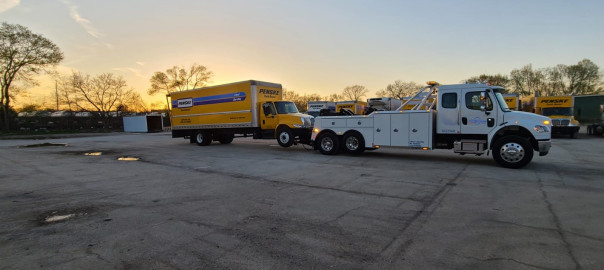Safety winching is one of the essential (and popular) roadside assistance services that we regularly provide clients throughout the entire Chicagoland area. In this blog entry, the vehicle recovery service experts here at Towing Chicago will thoroughly detail how to safely winch vehicles out of a ditch or another embankment.
When driving off road vehicles, the best tool for towing your vehicles right is a four wheeler winch. These tools can be a major boon especially when traveling on unsteady or rough terrain without any other vehicles. However, winches should only be used by experts as when operated by amateurs, they can cause great amounts of property damage or personal injury.
Vehicle Winches
Known as winch machines, winches maneuver objects and provide the specific service of pulling heavy vehicles out of ditches. Heavy duty recovery winches are made of different components that all have their unique role. The first component of a vehicle winch is its motor. Considered the most important part of a winch, the motor allows the winch to function. Winch motors might be hydraulic or electric, and are powered by steering pumps or vehicle batteries.
Winch cables
Winch cables, also known as winch ropes, are created with synthetic rope or steel. Winch cables range from 40 feet to 100 feet, and have a hook at their end that attaches to the vehicle.
Drums
Winch drums are circular and hollow, and provide a surface for the cable to be wrapped around. Winch drums are powered by the motor of the winch, and a spool of the drum which rotates to either unwind or wipe the winch cable.
Gear Trains
Gear trains are also called drive trains. Gear trains connect the vehicle’s motor to its gear system within the winch. It utilizes electrical energy from the vehicle’s engine, converting this energy into pulling power in order to allow the winch to haul very heavy objects or vehicles.
Rollers
Rollers help lead the winch cable – when it’s mounted on its drum – in a specific direction. Rollers also act as wear plates that protect the drum or the cable from damage.
Internal Brakes
The internal brake of the winch prevents the heavy load from slipping back into the ditch once the winch has stopped.
Winching Safety Stretching
Make sure to always stretch the winch cable before using it. Regardless of whether you have a synthetic winching rope or a steel cable, ensure that it’s stretched before you use it.
This is because when you set the winch out, the winch cable that’s just wrapped around the drum won’t be under any tension. By pulling the rope first, you’ll allow the rope to wind onto the drum evenly without bunching on itself. By doing this when the winch rope is loaded, it won’t get damaged or crushed under the pressure of knotting.
Also, make sure to anchor the winch to a very large heavy and steady tree. Pull the toe strap to a very tight level and anchor it to the tree – close to the ground – in order to create a very strong and steady pulling point.
Make sure to weigh the winch rope down with a tree limb, a heavy jacket, a backpack, a blanket, or anything heavy midway through the rope, between the anchor point, and the winch itself. This is essential especially as protection in the potential event of the rope snapping; the weight of this object will, in that case, keep the rope on the ground and prevent it from suddenly shooting back which could potentially cause serious injury.
During the winching process, you should stand at a safe distance away from the vehicle, the anchor, and the winch point. Hide behind a large tree or another car if one’s nearby. Also, never attempt a winching operation unless you have all of the right tools. These tools include recovery straps, snatch blocks, and ideally a pair of shackles, a pair of heavy gloves, and something very heavy that can weigh down the winch rope.
Winching Don’ts.
Never ever double back the hook to your winch line, because that will cause very serious damage to the rope – which in turn can cause rope snapping.
Use a tree strap
Use a tree strap and a shackle to keep the hook in a firm position. Never wrap the rope directly around a tree. Regardless of whether the rope is made of synthetic materials or a cable, never wrap it around a tree. This could potentially rip the tree down and is also very very dangerous for anybody nearby. If you’re using a tree as an anchor point, put a tree saver or a tree trunk protector around the tree before doing so then secure the anchor.
Never rush
Never rush a lynching process which can risk damage to you, any people nearby, or the vehicle. When winching, move very slowly. Think very carefully and thoroughl, and always double check all equipment before beginning the process. Lastly, never use a winch rope that’s fraying. This should be obvious: fraying winch ropes usually cause the most serious injuries that we see with winching operations. This includes breaking during winching or a potential serious injury to hands in the event that safety gloves are absent. If your winch rope is fraying, make sure to replace it as soon as possible and don’t use it until you do so.
Contact Towing Chicago today for the highest quality winching service available in the entire Greater Chicago area.

